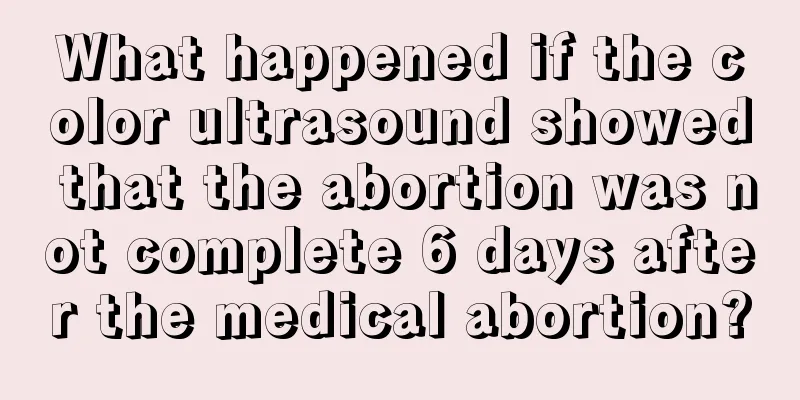What happened if the color ultrasound showed that the abortion was not complete 6 days after the medical abortion?

|
Faced with an unexpected pregnancy, many people will resort to artificial abortion to terminate the pregnancy, but medical abortion is safer, causing less pain to women and allowing for quicker recovery. However, there are exceptions to medical abortion, and it may even have a greater impact on your health. For example, what if a color ultrasound 6 days after a medical abortion shows that the abortion is not complete? Let’s take a look at the explanation below. Medical abortion refers to achieving an artificial abortion in the early stages of pregnancy without the need for surgery, but through injections or medication. It is of course simple, but the success rate is not high. Many women will experience symptoms of incomplete abortion. It refers to achieving artificial abortion in the early stages of pregnancy without the need for surgery, but through injections or medication. It is of course simple, but the success rate is not high. Many women will experience symptoms of incomplete abortion via medication. Of course, medical abortion has many advantages, but it also has its limitations and side effects. In order to ensure women's health, medical abortion must be performed in a medical institution with the necessary conditions. There are three outcomes of medical abortion: One is complete abortion, which means that the gestational sac is naturally expelled after taking the medicine, vaginal bleeding stops naturally, and the menstrual cycle comes normally. The second is incomplete abortion. After taking the medicine, the fetal sac is not expelled, or the expulsion is incomplete. In this case, curettage must be performed again. The third is failed abortion. After 8 days of medication, the fetal sac is not expelled, and B-ultrasound examination confirms that there is still pregnancy in the uterus. In this case, negative pressure suction abortion must be used. If the abortion is not complete, you must try to use medication to contract the uterus again to expel the remaining tissue. But if it still cannot flow out, a uterine curettage is necessary. Otherwise, if it remains in the uterus, it will cause serious consequences such as infection, heavy bleeding, infertility, etc., which will seriously threaten reproductive health. If readers experience relevant symptoms, they should pay enough attention to it and go to a regular specialist hospital as soon as possible. |
<<: Can I prepare for pregnancy while taking anti-inflammatory drugs during menstruation?
>>: Brown bloody vaginal discharge itchy for a week
Recommend
Is it normal to have back pain after IVF?
Generally speaking, for families that cannot conc...
What causes black menstrual period?
Menstruation is a very important physiological re...
This infectious disease is still spreading! Be careful when you go swimming or playing in the water!
Where are the most crowded places in summer? That...
How to take dydrogesterone tablets?
Dydrogesterone tablets are a drug used to treat h...
What novel is Tianwu Ji adapted from? Tianwu Ji novel free reading Baidu cloud resources
The Legend of Heaven Dance, starring Xu Kai and W...
Can cervical relaxation be restored?
As we get older, our skin will become loose, so w...
Is it harmful to draw eyebrows every day? Beauty experts tell you
Women will draw their eyebrows before going out, ...
Can you really tell the difference between renal cysts and polycystic kidney disease?
Although both renal cysts and polycystic kidney d...
Methods to help with pelvic flooring
If the fetus enters the pelvis, it means that the...
What are the most effective breast enhancement methods?
Nowadays, women are very concerned about their br...
Will I usually get constipated after having an abortion?
Many friends often have some health problems afte...
9 effective ways to warm the uterus and promote pregnancy
Uterine cold is a common gynecological disease am...
Causes of yellowish and bloody vaginal discharge
In daily life, many gynecological diseases are bo...
Is moxibustion effective for uterine fibroids?
Nowadays, many women have a new disease called ut...









